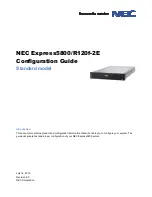
Chapter 1. Introduction to IBM Midrange System Storage storage subsystems
11
Serial ATA Hard Disk Drives (SATA HDD)
Serial ATA is the hard disk standard created to replace the parallel ATA interface (also
called IDE). Serial ATA transmits data in serial mode and implements two separated
datapaths, one for transmitting and another for receiving data. The standard transfer rate
is 1.5 Gbps for Serial ATA standard, although Serial ATA II (second generation) provides
new features, such as Native Command Queuing (NCQ), plus a higher speed rate of 3
Gbps. NCQ increases the hard disk drive performance by reordering the commands send
by the host. Through the speed-matching technology provided by the expansion
enclosures mentioned in 1.3, “IBM Midrange System Storage expansion enclosure” on
page 6, SATA hard disk drives are able to work with a transfer rate of 4 Gbps, enabling the
intermixing of high performance FC and high capacity SATA drives.
The DS4000 and DS5000 series can mount different types of FC HDDs in terms of size
and revolutions per minute (RPM):
– 500 GB/7.2k rpm SATA
– 750 GB/7.2k rpm SATA II (all the models)
– 1000 GB/7.2k rpm SATA II (all the models)
– 2000 GB/7.2k rpm SATA II (only EXP5000)
1.6 iSCSI basics
All the DS5000 series models now support iSCSI host connectivity and in this section we
briefly describe the basics of the iSCSI protocol. Consult Appendix B, “Deploying iSCSI host
interface controllers on the IBM System Storage DS5000 series” on page 515 for more
detailed information.
iSCSI is an industry standard developed to enable transmission of SCSI block commands
over the existing IP network by using the TCP/IP protocol. The TCP/IP protocol provides
iSCSI with inherent reliability along with byte by byte, in order delivery, built-in security, and no
interoperability barriers.
When a user or application sends a request, the operating system generates the appropriate
SCSI commands and data request, which then go through encapsulation. A packet header is
added before the resulting IP packets are transmitted over an Ethernet connection. When a
packet is received, it is disassembled, separating the SCSI commands and request. The
SCSI commands are sent on to the SCSI controller, and from there to the SCSI storage
device. Because iSCSI is bi-directional, the protocol can also be used to return data in
response to the original request.
Summary of Contents for System Storage DS4000
Page 2: ......
Page 18: ...xvi IBM Midrange System Storage Hardware Guide...
Page 40: ...22 IBM Midrange System Storage Hardware Guide...
Page 302: ...284 IBM Midrange System Storage Hardware Guide...
Page 344: ...326 IBM Midrange System Storage Hardware Guide...
Page 372: ...354 IBM Midrange System Storage Hardware Guide Figure 7 25 Drive firmware Incompatible...
Page 490: ...472 IBM Midrange System Storage Hardware Guide...
Page 522: ...504 IBM Midrange System Storage Hardware Guide...
Page 544: ...526 IBM Midrange System Storage Hardware Guide...
Page 561: ...Index 543 Z zoning 129 130...
Page 562: ...544 IBM Midrange System Storage Hardware Guide...
Page 564: ...IBM Midrange System Storage Hardware Guide IBM Midrange System Storage Hardware Guide...
Page 565: ......
















































